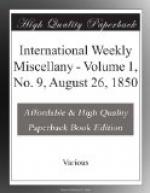“One day my kind friend Colonel S. took me to hear a debate in the Senado, the Spanish Chamber of Peers, which holds its sittings in the chapel of a suppressed convent, near the palace. By dint of paint, gilding, and carpets, the room has been divested of its sanctified aspect, and made to look like a handsome modern room. They have not thought it necessary that a place in which a hundred gentlemen in surtouts meet to discuss secular matters in this nineteenth century, should be made to resemble a chapel of the fifteenth. Antiquity is here represented in the person of two halberdiers, who stand to guard the door, dressed in extravagant costume, like beefeaters in full bloom. Rows of raised seats extend on each side of the room; in the center, facing the beef-eaters, are the chair and desk of the president, and on each side a little tribune, from which the clerks read out documents from time to time. The spectators are accommodated in niches round the walls. Each member speaks from his place, and the voting is by ballot. First a footman hands round a tray of beans, and then each advances, when his name is called, to a table in the center, where he drops his bean into the box. The beans are then counted, and the result proclaimed by the president. On the right of the chair, in the front, is the bench assigned to the ministers; and there I had the good luck to see Narvaez, otherwise called Duke of Valencia, and a great many fine names besides, and, in reality, master of all the Spains. His face wears a fixed expression of inflexible resolve, very effective, and garnished with a fierce dyed mustache, and a somewhat palpable wig to match. His style of dress was what, in an inferior man, one would have called ‘dandified.’ An unexceptionable surtout, opened to display a white waistcoat with sundry chains, and the extremities terminated, respectively, in patent leather and primrose kid. During the discussion he alternately fondled a neat riding-whip and aired a snowy pocket-handkerchief. Those who know him give him credit for good intentions and great courage, but do not expect that he will ever set the Thames on fire, whatever he may do to the Manzanares. He is a mixture, they say, of the chivalric and the asinine: a kind of moral mule. His personal weakness is a wish to be thought young, and hence he was naturally angry when Lord Palmerston wanted to give him a ‘wrinkle.’ I saw, likewise, Mon, the Minister of Finance, smiling complacently, like a shopkeeper on his customers; and the venerable Castanos, Duke of Bailen, who, as he tottered in, stooping under the weight of ninety years, was affectionately greeted by Narvaez and others. On the whole, the debate seemed to be languid, and to be listened to with little interest; but that is the general fate of debates in July.”
* * * * *
THE KANASZ.
Of the Servian swineherd we have heard something of late, both in history and romance; because this was the vocation of Kara George, the Servian Liberator. In Hungary the swine-keeper does not seem to be so respectable a person. Here is a sketch of him from Max Schlesinger’s new book on the Hungarian war:




